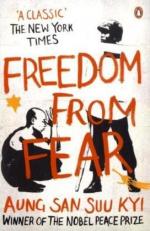
|
| Name: _________________________ | Period: ___________________ |
This quiz consists of 5 multiple choice and 5 short answer questions through Part 2: Section 14.
Multiple Choice Questions
1. According to Aung San Suu Kyi, what corrupts individuals?
(a) Money.
(b) Fear.
(c) Greed.
(d) Power.
2. In Suu Kyi's speech on December 3, 1988, what are Suu Kyi's beliefs about democracy in Burma?
(a) Democracy is around the corner.
(b) Democracy can only exist in Burma in an adulterated form.
(c) Democracy is an illusive dream.
(d) Democracy is still possible.
3. What was different about the human rights violation than previous circumstances that Suu Kyi cites in her second letter to Amnesty International?
(a) That it is occuring in broad daylight.
(b) That the incidences are increasing.
(c) That is involves children.
(d) That a person inside of the regime is speaking against these practices.
4. According to Suu Kyi, what brought the crowd together at the Shwedagon Pagoda in Rangoon on 26 August 1988?
(a) A "desire for change."
(b) A "showing of solidarity against the oppressive regime of Burma."
(c) A "growing discontent among the people."
(d) The "unshakable desire to strive for a multi-party democratic system"
5. Suu Kyi states in her speech Shwedagon Pagoda in Rangoon on 26 August 1988 that she is not beholden to any politician so that...
(a) No one can ever force Suu Kyi to betray them.
(b) She can act and think independently.
(c) No one force her hand to act in a way that violates her conscience.
(d) She does not play a role in the corruption and the scandals.
Short Answer Questions
1. What was the Burmese approach to life during British occupation?
2. At the end of Suu Kyi's speech at the Shwedagon Pagoda in Rangoon on 26 August 1988, she restates their common goal, which is
3. According to Suu Kyi, in her speech on December 3, 1988, what is the life expectancy of someone in a dictatorship?
4. What does not allow fear to dictate behavior?
5. How does Suu Kyi conclude her first letter to Amnesty International?
|
This section contains 384 words (approx. 2 pages at 300 words per page) |

|




